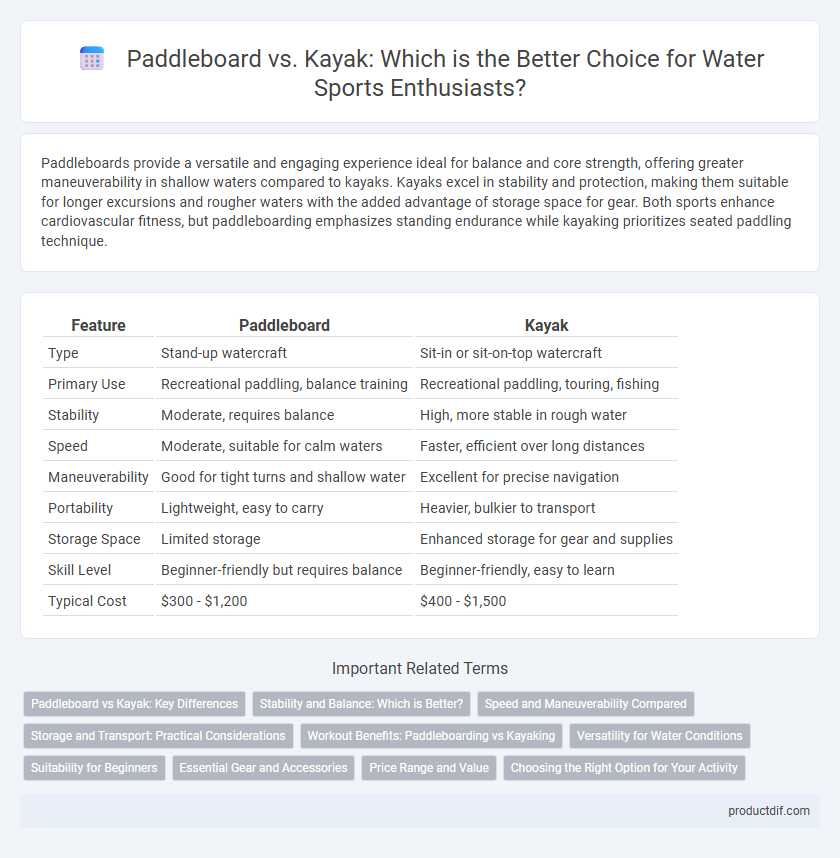Paddleboards provide a versatile and engaging experience ideal for balance and core strength, offering greater maneuverability in shallow waters compared to kayaks. Kayaks excel in stability and protection, making them suitable for longer excursions and rougher waters with the added advantage of storage space for gear. Both sports enhance cardiovascular fitness, but paddleboarding emphasizes standing endurance while kayaking prioritizes seated paddling technique.
Table of Comparison
| Feature | Paddleboard | Kayak |
|---|---|---|
| Type | Stand-up watercraft | Sit-in or sit-on-top watercraft |
| Primary Use | Recreational paddling, balance training | Recreational paddling, touring, fishing |
| Stability | Moderate, requires balance | High, more stable in rough water |
| Speed | Moderate, suitable for calm waters | Faster, efficient over long distances |
| Maneuverability | Good for tight turns and shallow water | Excellent for precise navigation |
| Portability | Lightweight, easy to carry | Heavier, bulkier to transport |
| Storage Space | Limited storage | Enhanced storage for gear and supplies |
| Skill Level | Beginner-friendly but requires balance | Beginner-friendly, easy to learn |
| Typical Cost | $300 - $1,200 | $400 - $1,500 |
Paddleboard vs Kayak: Key Differences
Paddleboards offer a standing position that enhances balance and core strength, while kayaks provide seated comfort with better stability and storage capacity. Kayaks excel in rough water conditions and long-distance paddling due to their streamlined design, whereas paddleboards are more versatile for activities like yoga and surfing. Choosing between a paddleboard and kayak depends on your intended use, skill level, and water environment preferences.
Stability and Balance: Which is Better?
Paddleboards offer superior balance challenges that engage core muscles more intensively, making them ideal for improving stability and coordination over time. Kayaks provide a lower center of gravity and enclosed seating, delivering inherent stability that benefits beginners and rough water conditions. Choosing between a paddleboard and kayak depends on whether dynamic balance training or immediate stability in varied waters is the priority.
Speed and Maneuverability Compared
Paddleboards generally offer greater speed on flat water due to their lighter weight and streamlined shape, allowing for swift gliding and efficient paddling. Kayaks, while typically heavier, provide superior maneuverability in varied water conditions thanks to their enclosed design and rudder systems, enabling precise turns and control in waves or currents. Choosing between the two depends on whether speed or agility in water navigation is the primary priority for the user.
Storage and Transport: Practical Considerations
Paddleboards are typically lighter and more compact, allowing for easier storage in small spaces and simpler transport on car roofs or in vehicle trunks. Kayaks, while heavier and bulkier, often feature built-in storage compartments for gear, making them ideal for longer trips where equipment needs secure storage. Inflatable paddleboards offer the added advantage of deflating for compact storage and portability compared to rigid kayaks.
Workout Benefits: Paddleboarding vs Kayaking
Paddleboarding engages core muscles, improves balance, and enhances cardiovascular endurance through dynamic full-body movement. Kayaking primarily targets upper body strength, including arms, shoulders, and back, while also boosting aerobic fitness and coordination. Both activities offer low-impact workouts suitable for all fitness levels, with paddleboarding promoting greater balance control and kayaking providing intense upper body conditioning.
Versatility for Water Conditions
Paddleboards excel in versatility across calm lakes and mild ocean waves, offering stability for yoga, fishing, and cruising, while kayaks provide superior control and speed in rough waters and whitewater conditions. Paddleboards allow easy transition between paddling and standing activities, suitable for diverse water environments with varying depths. Kayaks enhance maneuverability and safety in turbulent or narrow waterways, making them ideal for adventurous or technical water sports.
Suitability for Beginners
Paddleboards offer a more stable platform, making them ideal for beginners seeking balance and ease of maneuverability on calm waters. Kayaks provide better control and speed but require familiarity with paddling techniques, which may challenge novices initially. Choosing between the two depends on the beginner's preference for standing or sitting and their comfort with basic water navigation skills.
Essential Gear and Accessories
Essential gear for paddleboarding includes a high-quality paddleboard, a paddle tailored to the rider's height, and a personal flotation device for safety. Kayaking requires a durable kayak, a double-bladed paddle, and often a spray skirt to prevent water from entering the kayak. Both sports benefit from accessories like waterproof dry bags, safety whistles, and proper footwear to enhance the experience and ensure safety on the water.
Price Range and Value
Paddleboards typically range from $300 to $1,200, offering versatile use for surfing, touring, and yoga at a moderate price point, while kayaks generally cost between $400 and $2,000, reflecting specialized designs for fishing, whitewater, and recreational paddling. Value in paddleboards comes from lightweight construction and portability, appealing to casual users seeking multifunctionality; kayaks deliver greater stability and storage, justifying higher prices for enthusiasts needing durability and advanced features. Choosing between the two depends on budget constraints and intended water activities, as both provide strong value within their respective price ranges.
Choosing the Right Option for Your Activity
Selecting between a paddleboard and a kayak depends on your preferred water activity and skill level. Paddleboards offer a versatile, full-body workout ideal for calm waters and yoga sessions, while kayaks provide stability and speed suitable for longer trips and rougher conditions. Assess factors such as balance, portability, storage, and the type of water environment to determine the best fit for your recreational needs.
Paddleboard vs Kayak Infographic

 productdif.com
productdif.com